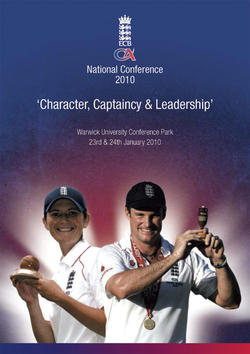|
 Knowledge is a tool used by coaches to make better cricketers. Knowledge is a tool used by coaches to make better cricketers.
That's why the ECBCA conference is such an important event for all coaches: You surround yourself with such passionate and knowledgeable people, all of whom love sharing their knowledge of the game.
Of course, the PitchVision Academy Director of Coaching (otherwise known as me) was in attendance for the 2010 event. The theme was "Character, Captaincy and Leadership". I met a lot of excellent coaches from all over the UK (and some from further afield) and learned a lot.
Of course, I would be doing you a disservice if I didn't dish some of the secrets I picked up over the weekend. This is the whistle-stop version and I'll be going into more detail in further articles and cricket show podcasts. You can get them by putting your name down for the free newsletter.
Outside the lecture hall
The weekend was packed with events, practical and theoretical, but the really interesting conversations happened in-between them: Sharing ideas and experiences with coaches who are working with players regularly.
These are the coaches that care enough to pay to take a weekend to develop their coaching skills. They are the ones with the passion to make the best players they can. I was proud to find out many of them already read the PitchVision Academy newsletter.
Even if I had learned nothing in the lecture hall, the delegates had won me over. The biggest lesson from the conference was this: Surround yourself with passionate people and feed from each others enthusiasm.
The big problem
The conference itself has a wide range of attendees. Coaches who work with 11 year old beginners are not going to want the same thing as those dealing with international players, but all levels where there.
This means a lot of ideas can be lost.
But it's important not to see the conference as a waste of time because of that. If a coach takes away one idea that he or she can apply to cricketers they coach then it's been worth it. You can't expect to take it all in, but a few key themes can be taken away.
It's not all about technique
A surprising part of my experience in the conference was the lack of technical stuff.
No long lectures on the importance of head position or seminars on improving bat speed. This conference was about other things: How to be streetwise, how to lead people and developing team spirit.
Judging by the feedback we get here on PitchVision Academy, these are often overlooked topics. Of the categories we cover, captaincy is 6th most popular, tactics are 11th and psychology is 13th. Skill based topics dominate reader interest, especially batting which is more than twice as popular as the 2nd category (drills).
But the conference showed me that it's just as important to be tuned into leadership and mental skills as it is to be able to play a cover drive, even at very junior levels.
The only difference between the levels is how you introduce and develop those skills to players.
Of course, skill is crucial, but as Dr Steve Bull said in his presentation, a winning team environment is what really makes the difference.
To get the real value of the conference, you had to be there. It was a tough weekend with so much to take it, but it was worth every moment.
If you were there and met me (or didn't, I couldn't get round everyone), drop me a line to say hello.
If you couldn't be there, I'll pass on as much as I can to you through the PitchVision Academy cricket coaching newsletter. If you are a coach or player, it's not to be missed.
Discuss this article with other subscribers
|

.jpg)




.jpg)


